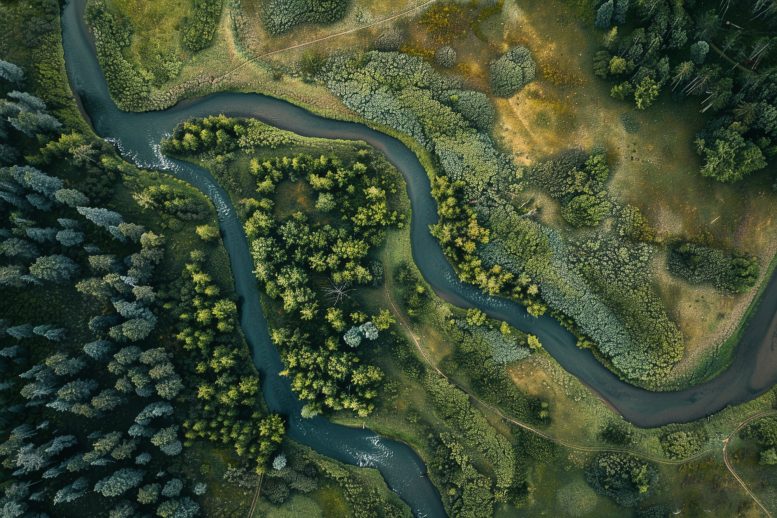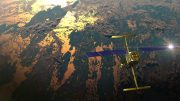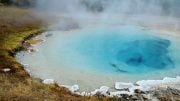
Climate change is disrupting the natural seasonality of river flows in northern regions, posing significant threats to ecosystems and water security, with human-induced climate change identified as the primary cause. Credit: SciTechDaily.com
New research indicates that climate change is altering the seasonal river flows in the far northern regions of America, Russia, and Europe, presenting risks to water security and natural ecosystems.
A team of scientists led by the University of Leeds analyzed historical data from river gauging stations across the globe and found that 21% of them showed significant alterations in the seasonal rise and fall in water levels.
The study used data-based reconstructions and state-of-the-art simulations to show that river flow is now far less likely to vary with the seasons in latitudes above 50°N than previously, and that this could be directly linked to changes to the climate caused by human activity.
Until now, evidence suggesting that climate change has had an impact on river flow seasonality has been limited to local studies or has failed to consider the impact of climate change brought about by humans explicitly.
In this study, the team used monthly average river flow measurements from 10,120 gauging stations from 1965 to 2014.
For the first time ever, they were able to exclude direct human interventions such as reservoir management or water extraction, to show that widespread reduction in river flow seasonality was driven by climate change.
The results of the research, which was funded by the University of Leeds and the Southern University of Science and Technology in China was recently published in the journal Science.
Lead author, Hong Wang, a PhD researcher at the University of Leeds and the Southern University of Science and Technology in China, said: “Our research shows that rising air temperatures are fundamentally altering the natural patterns of river flow.
“The concerning aspect of this change is the observed weakening of river flow seasonality, and that this is as a direct consequence of historical human-induced emissions. This signals a sustained and considerable diminishment of river flow seasonality if air temperatures continue to rise.”
Human impact on river flow
Human activities are altering river flow patterns worldwide, both directly through flow regulations such as reservoirs, and indirectly through land use change and the impacts of climate change on air temperature, precipitation, soil moisture, and snowmelt.
Over two-thirds of the world’s rivers have already been altered by humans even without considering the indirect impacts of increases in greenhouse gases and aerosols.
River flow seasonality plays a critical role in the predicted cycle of floods and droughts. A weakening of these peaks and troughs can threaten water security and freshwater biodiversity. For example, a substantial portion of the early meltwater from snowpack depletion may quickly flow into oceans and therefore not be available for human use.
Weakening river flow seasonality – for example, due to a reduction in spring and early summer river levels in snowmelt regions – can also have an impact downstream on riverbank vegetation and organisms living in the river itself.
Gauging the seasonal flow
In northern North America, the researchers found that 40% of the 119 stations observed showed a significant decrease in river flow seasonality. Similar results were also observed in southern Siberia with 32% of stations showing a significant decrease.
There was a comparable pattern in Europe, with 19% of the river gauging stations experiencing a significant decrease – mainly in northern Europe, western Russia, and the European Alps.
In addition, regions in the contiguous United States (the lower 48 states in North America, including the District of Columbia) showed predominantly decreasing trends of river flow seasonality overall, except for rivers in the Rocky Mountains and Florida.
In central North America, the research showed significant decreasing river flow seasonality trends in 18% of the stations.
By contrast, the researchers found a significant increase in river flow seasonality in 25% of the gauging stations in southeast Brazil, showing that changes to the water cycle are having a different impact in some parts of the world.
Dr Megan Klaar, an Associate Professor in the University of Leeds School of Geography and a member of water@leeds, co-authored the research. She said: “The highs and lows of river flow during the different seasons provide vital cues for the species living in the water.
“For example, a lot of fish use particular increases in the water as a cue to run to their breeding areas upstream or towards the sea. If they don’t have those cues, they won’t be able to spawn.”
The research concludes that there is a need to accelerate climate adaptation efforts to safeguard freshwater ecosystems by managing flows to try to recreate some of the natural systems and processes that are being lost.
Professor Joseph Holden, the Director of water@leeds and who supervised Hong Wang’s research, added: “A lot of concern is based upon what climate change will do in the future but our research signals that it’s happening now and that increases in air temperature are driving huge changes in river flow.
“We should be very concerned about what the future holds given accelerating climate change and begin to think about mitigation strategies and adaptation planning to alleviate the future weakening of seasonal river flow, particularly in locations such as western Russia, Scandinavia, and Canada.”
Reference: “Anthropogenic climate change has influenced global river flow seasonality” by Hong Wang, Junguo Liu, Megan Klaar, Aifang Chen, Lukas Gudmundsson and Joseph Holden, 29 February 2024, Science.
DOI: 10.1126/science.adi9501









Be afraid, very afraid!
Run around with your hair on fire!
“A weakening of these peaks and troughs can threaten water security and freshwater biodiversity.”
Yet, dam building has been motivated by a desire to weaken the peaks and troughs, preventing floods and insuring water availability all year long! They then say, “For example, a substantial portion of the early meltwater from snowpack depletion may quickly flow into oceans and therefore not be available for human use.” That undermines their previous claim because the example is a case of the peak being increased. Perhaps what they intended to say was that decreased runoff was a concern, which is a concern to agricultural communities and native plants and wildlife. Although, the Arctic — a cold desert — doesn’t have the kind of snow falls common in mountains at lower latitudes and doesn’t have the population densities at lower latitudes.
However, other studies suggest an increase in precipitation as a warming Earth results in more evaporation and transpiration. The answer probably lies in a middle-ground: “By contrast, the researchers found a significant increase in river flow seasonality in 25% of the gauging stations in southeast Brazil, showing that changes to the water cycle are having a different impact in some parts of the world.” In other words, there is a regression about the means, or a tendency for things to balance out across the surface.